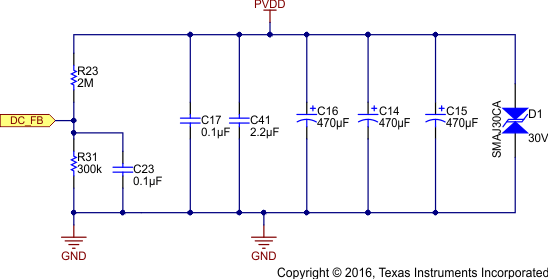TIDUCL0 January 2017
- 1 Description
- 2 Resources
- 3 Features
- 4 Applications
- 5 Design Images
- 6 System Overview
-
7 System Design Theory
- 7.1 Power Stage Design—Battery Power Input to the Board
- 7.2 Power Stage Design—Three-Phase Inverter
- 7.3 Power Stage Design—DRV8323 Gate Driver
- 7.4 Power Stage Design—18-V to 3.3-V DC-DC Converter
- 7.5 Power Stage Design —Microcontroller MSP430
- 7.6 Power Stage Design—Hall Sensor Interface
- 7.7 Temperature Sensing
- 7.8 Power Stage Design—External Interface Options and Indications
- 8 Getting Started Hardware and Software
- 9 Testing and Results
- 10Design Files
- 11Software Files
- 12Related Documentation
- 13Terminology
- 14About the Author
7.1 Power Stage Design—Battery Power Input to the Board
The battery power input section is shown in Figure 2. The input bulk aluminum electrolytic capacitors C14, C15, and C16 provide the ripple current and its voltage rating is de-rated by 50% for better life. These capacitors are rated to carry high ripple current. C17 is used as bypass capacitors to GND. D1 is the transient voltage suppression (TVS) having breakdown voltage of 30 V and maximum supply voltage of 30 V.
 Figure 2. Schematic of Battery Power Input Section
Figure 2. Schematic of Battery Power Input Section The input supply voltage PVDD is scaled using the resistive divider network, which consists of R23, R31, and C23, and fed to the MCU. Considering the maximum voltage for the MCU ADC input as 3.3 V, the maximum DC input voltage measurable by the MCU is calculated as in Equation 1.

Considering a 20% headroom for this value, the maximum recommended voltage input to the system is 25.3 × 0.8 = 20.25. So for a power stage with maximum operating voltage of 21 V, this voltage feedback resistor divider is ideal. Also, this choice gives optimal ADC resolution for a system operating from
6 to 21 V.